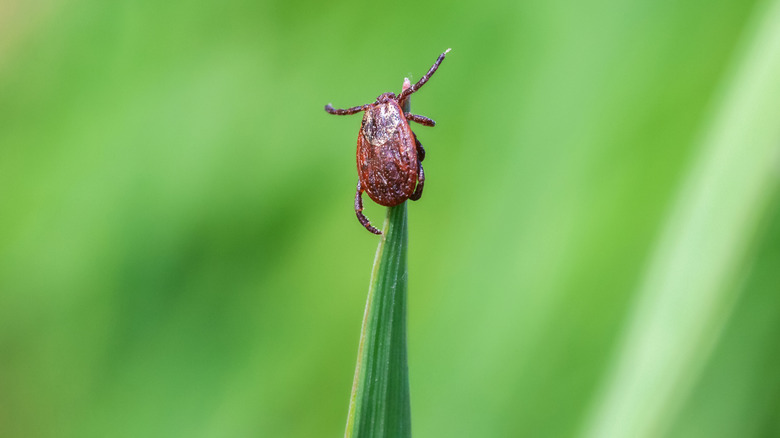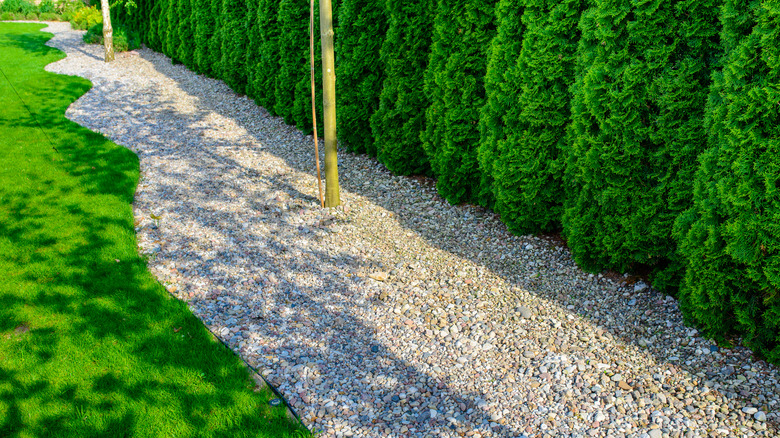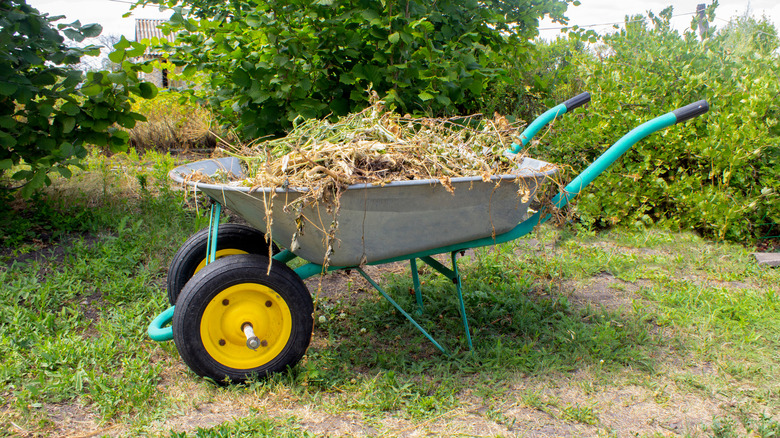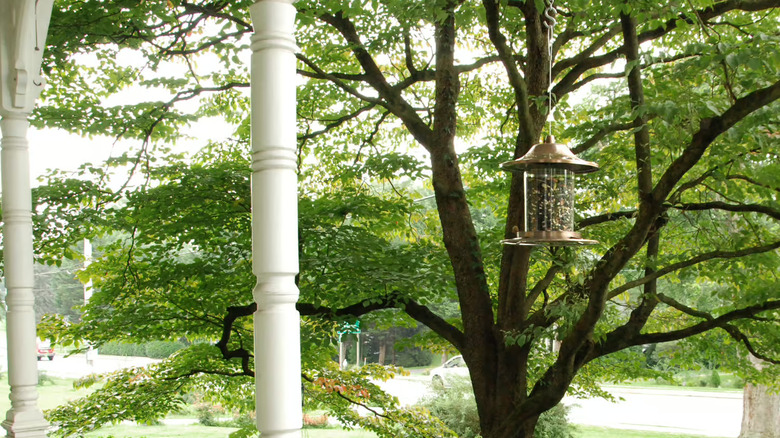How To Tick-Proof Your Lawn Without Nasty Chemicals
We may receive a commission on purchases made from links.
Ticks are unwelcome guests found throughout the United States. They're notorious for taking refuge in residential lawns and gardens, ready to strike any person, pet, or wild animal that walks past. Most people have a general "ick" for insects, but ticks give us that feeling for a good reason; they cause irritation, itching, and transmit diseases through bites. They're a nuisance and danger to animals and people alike, and it's common to take desperate measures to deter them.
At the first sight of bugs, chemical pesticides are often the first resort. Although effective, these methods can also be toxic to people and pets. Fortunately, they aren't the only method for combating dangerous insects like ticks. There are natural solutions for tick-proofing a lawn and making a home a less attractive stomping ground. So, be proactive and learn how to stop ticks from taking over your yard before they begin their invasion.
Luckily, there are natural ways to deter ticks without utilizing unnatural chemicals. We'll discuss how to implement these strategies so you can declare war on local tick populations. Learn why these methods work, tips for setting them up, and how reliable these hacks are.
Build an outdoor barricade against ticks
Building a barricade has been humankind's answer to stopping invaders for millennia, and this advice also works against insects. Defend your home and yard from surrounding forests and neighbors' yards by laying a barrier of ground that ticks won't cross. Wood chips, mulch, and gravel don't provide food or much shade for ticks, making these great, affordable assets to surround a property.
Set up at least 3 feet of these materials to create a no-man's land that ticks won't be likely to venture into. Use an online calculator to determine how much gravel or mulch you'll need. If building the barrier yourself, you'll need a rake, shovel, and tamper to prepare the space. You may want to use natural landscape edging ideas as the border to hold smaller pieces of gravel and wood chips in place. A weed barrier fabric, like Winisok's Weed Barrier Landscape Fabric, should also be laid down to keep invasive plants from popping through your barrier.
Keep your garden pruned and maintained
Ticks are big fans of humid and shady areas. Less shade may mean that fewer ticks will set sights on your property. Trim down overgrown shrubs and flower gardens to minimize shelter for ticks. The less bushy growth, the less shade there is for them to hunker down in. It's also recommended to keep your lawn mowed, but there is not much evidence to support that this truly deters ticks. In a 2019 National Science Foundation study, scientists reported there wasn't a significant difference between the number of ticks in a managed and unmanaged lawn. These insects don't take shelter under grass blades, even when unmanaged and somewhat overgrown.
The best approach is to stop neglecting critical garden and lawn maintenance. Keep an eye on your property, and prune back stray branches and twigs as you notice plants becoming scraggly. Most garden plants grow faster in the spring and summer, and you may have to trim more often during that time. However, make sure you avoid mistakes while pruning your plants that could impact their overall health.
Set up tick-proof playgrounds
An outdoor playground is a great way to get kids off the couch and outside with nature. However, parents have a right to fear the ticks that live throughout most of the Eastern and some of the Western United States. Fortunately, a strategic setup can deter native ticks from playground areas. Choose a playground floor that ticks won't use for shelter, and keep the setup as far away from tick-infested areas as possible.
Ignore the temptation to set up the slide or swing set near trees and forested areas for shade. Instead, place them in the bright sun, in the center of your yard, where ticks can't hide in the shade to reach them. As an extra safety precaution, avoid putting the playground on natural grass. Grass doesn't absorb impacts much when kids fall, and it may not be a solid, flat surface for playground equipment. Instead, lay an underlayment of wood chips or mulch, which again doesn't appeal to a tick's natural instincts. Mulch may seem more dangerous than grass for a child's play area, but it's a better landing pad for falls. However, there is a risk of splintering, so a rubber mulch alternative might be the best option for your playground area. Don't forget to lay landscape edging around the perimeter of the playground to keep the underlayment in place and build another wall against invading insects.
Install fencelines to keep unwanted animals away
Ticks don't travel all on their own. They hitch rides on other animals, like deer, raccoons, stray cats, and even birds. When wild animals venture into your yard, they can bring ticks with them, introducing these insects to your space. To keep the ticks out, use humane ways to keep critters out of your yard. Hang wind chimes, seal trash cans, plant mammal-deterring plants, and, most importantly, build a fence.
A physical obstruction is the most helpful, especially if you use effective types of fences for keeping animals and pests out. Groundhogs, rabbits, skunks, gophers, and raccoons will dig underneath, and deer can clear a 7-foot-tall fence. Consider what local wildlife could be carrying ticks in your area before choosing the best fence design. A buried wire fence will help keep the diggers out, and an 8-foot tall fence may be tall enough to keep deer out. An electric fence is also plausible, though this isn't the most humane approach.
Remove debris and clutter from your property
Homeowners on large properties or places without HOAs aren't badgered to keep their lawns looking a certain way. Families may fall into the habit of piling outdoor areas with unwanted debris and clutter, like old furniture and broken tools. Trashed properties are more than an eyesore. They create prime housing for ticks, especially if they have weeds growing around them. Clearing out the mess reduces more infestations than ticks. It will also deter termites, rodents, and other threatening pests that carry ticks or are just as dangerous.
Clearing out clutter on your property gets harder the longer it's been there. Many woods, metals, and fabrics break down when left outside and may be growing mold and mildew. Depending on the scale of the mess, there are a few ways to approach this clean-up. Start by dressing to prevent tick bites. Wear gloves, pants tucked into your socks, and a tucked-in long-sleeve shirt. Make sure all of these garments are lightly colored so bugs are visible if they land on you. Rent a local dumpster and start heaving heavier items into it. Once the bigger items are cleared out, go over the yard with a rake or shovel, scooping remnants of trash to also add to the dumpster. Once everything is cleared out, consider laying grass seed or sod to add greenery to your yard without increasing the risk of ticks.
Treat outdoor furniture and gear with cedarwood oil
Keep outdoor furniture from becoming a tick haven by treating it with non-toxic formulas. Cedarwood oil has been proven to repel most tick species. Black-legged, brown dog, American dog, and lone star ticks, which are common North American pests, are deterred by this compound. In fact, Cedrol, a compound in cedarwood oil, is more than a deterrent. High dosages can even kill tick species.
The only downside of cedarwood oil is that applications aren't permanent. As a general rule, this essential oil needs to be applied bi-weekly and after heavy rainfall to maintain its potency. Cedarcide's All-Purpose Bug Spray is safe to mist on most furniture and fabrics. Due to the lack of toxic chemicals, it's also safe to apply to people, pets, and plants. Cedarcide recommends their product be reapplied weekly to ensure you stay safe from ticks with these simple ingredients.
Plant herbs and flowers with fragrant scents
Cedarwood isn't the only fragrance that ticks find unsavory. You can keep many pesky ticks at bay with the help of beautiful plants like fragrant herbs, flowers, and vegetables. However, they only work as a deterrent, not a natural pesticide. Sweet-smelling flowers like chrysanthemums and marigolds have a strong scent that ticks find unsavory. Fragrant herb and vegetable plants like lemongrass, garlic, and rosemary are also potent.
These plants should be planted and used alongside other tick-repelling methods, since they aren't effective as sole prevention. Also, take care to remove plants that may be attracting ticks to your yard. Invasive Amur honeysuckle and multiflora roses are commonly inhabited by ticks, so remove and replace these plants if they're present.
Avoid using tick-appealing ground cover plants
The aforementioned invasive plants should be removed from your property, as should groundcover plants. Groundcover plants beautify patchy lawns where grass won't grow, and they have aesthetic value. However, you'll want to avoid growing tick-attracting types in your yard, which appeal to insects by providing humidity, shade, and cooler temperatures.
Avoid planting low-lying groundcover plants like pachysandra and Japanese barberry. Instead, grow groundcover that gives off scents that are unappealing to insects, like creeping rosemary, lavender, and mint. Spray these plants with cedarwood oil to increase their effectiveness at deterring ticks. One caveat, as was mentioned previously, is that the spray will have to be reapplied after rain and routine waterings. Another option is to omit groundcover plants entirely and opt for non-living groundcover, such as gravel or mulch.
Limit your number of bird feeders
Don't put all your focus on the wild mammals bringing ticks into your yard, and turn your sights toward the skies. Birds are also likely to be hosts for ticks, and migratory songbirds are notorious for indirectly spreading diseases. Coincidentally, these birds also enjoy stopping at bird feeders. Limiting the number of feeders can cut down on the population of tick hosts that visit your yard. On another note, deer are also attracted to bird feeders, which could be another factor upping the insect populations on your lawn.
You don't have to swear off all bird feeders, but it may be easier to keep ticks at bay if you stick to a single setup. Put up one bird feeder and keep it away from your home, pool, playground, or other regularly visited outdoor areas. Make sure the feeder is a hanging design that's far out of reach for deer and other mammals. Invest in a squirrel-proof feeder like the Kingsyard Caged Bird Feeder, since squirrels are also known to carry these disease-spreading bugs.
Implement xeriscaping to create dry, inhospitable conditions for ticks
If you're willing to go all the way and live in a suitable climate, consider redesigning your entire landscape into a xeriscape. Xeriscapes are the desert versions of a traditional landscape, filled with succulents, cacti, gravel, and mulch rather than traditional greenery and grass. These landscapes are highly drought-tolerant. So, they're dry and don't offer much shade, making them highly inhospitable for ticks. In a 2021 Journal of Medical Entomology study, xeriscaping was the only tick prevention method that immediately and permanently worked within a landscaped area.
There is a common misconception that xeriscape lawns have limited design and plant options. Contrary to this fact, multiple groundcovers, grasses, flowers, shrubs, and trees do well in a desert-like environment. Look for low-maintenance garden and lawn plants that thrive in full sun and dry conditions, like lavender and sage, that have strong smells that deter ticks. The crossover will create a perfect flora assortment for a landscape while keeping dangerous insects away.







